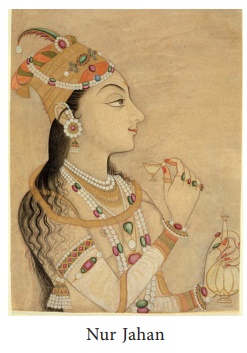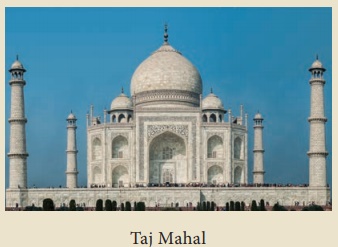The Mughal Empire - Shah Jahan (1627-1658) | 11th History : Chapter 14 : The Mughal Empire
Chapter: 11th History : Chapter 14 : The Mughal Empire
Shah Jahan (1627-1658)
Shah Jahan (1627-1658)
When Shah Jahan ascended the throne in Agra his
position was secure and unchallenged. Yet the affairs of the empire needed attention.
The Afghan Pir Lodi, with the title Khanjahan, who had been governor of the
southern provinces of the empire was hostile. Despite Shah Jahan’s order
transferring him from the government of the Deccan, he aligned with Murtaza
Nizam Shah II, the Sultan of Ahmed-Nagar, and conspired against Shah Jahan. As
the situation turned serious, Shah Jahan proceeded to the Deccan in person. The
newly appointed governor of the Deccan, Iradat Khan, who received the title
Azam Khan led the imperial army and invaded the Balaghat. Seeing the
devastation caused by the imperial troops, Murtaza changed his attitude towards
Khanjahan. Khanjahan thereupon fled from Daulatabad into Malwa, but was pursued
and finally slain. Peace thus having been restored in the Deccan, Shah Jahan
left the Deccan after dividing it into four provinces: Ahmednagar with
Daulatabad; Khandesh; Berar; and Telengana. The viceroyalty of the four
provinces was conferred by Shah Jahan on his son Aurangzeb, then eighteen years
of age.
Deccan Sultanates
After flourishing for over a hundred
years the Bahmani kingdom, that covered much of Maharashtra and Andhra along
with a portion of Karnataka, disintegrated and powerful nobles carved out new
dominions at Golkonda (Qutb Shahs), Bijapur (Adil Shahs), Berar (Imad Shahs),
Bidar (Barid Shahs) and Ahmad Nagar (Nizam Shahs), which go by the collective
name of Deccan Sultanates or Southern Sultanates.
Thus the Deccan was brought under the effective
control of the Mughal empire during the reign of Shah Jahan. Ahmad Nagar, which
offered resistance to the Mughals, was annexed despite the efforts of Malik
Ambar. Shah Jahan, with the help of Mahabat Khan, subdued the Nizam Shahi
rulers of Ahmad Nagar in 1636. When the Shi’ite Qutub Shahi ruler of Golkonda
imprisoned his own minister Mir Jumla it was used as a pretext by Aurangzeb to
invade Golkonda. A treaty made the Qutub Shahi ruler a vassal of the Mughal
empire.
European Factories/Settlements during Mughal Rule
Portuguese
In 1510, Albuquerque captured Goa
from the ruler of Bijapur and made it the capital of the Portuguese Empire in
the East. Subsequently Daman, Salsette and Bombay on the west coast and at
Santhome near Madras and Hugli in Bengal on the east coast had become
Portuguese settlements.
Dutch
The Dutch set up factories at
Masulipatam (1605), Pulicat (1610), Surat (1616), Bimilipatam (1641), Karaikal
(1645), Chinsura (1653), Kasimbazar, Baranagore, Patna, Balasore, Nagapattinam
(all in 1658) and Cochin (1663).
Danes
Denmark also established trade
settlements in India and their settlements were at Tranquebar in Tamilnadu
(1620) and Serampore, their headquarters in Bengal.
French
Surat (1668), Masulipatnam (1669),
Pondicherry, a small village then (1673), Chandernagore in Bengal (1690). Later
they acquired Mahe in the Malabar, Yanam in Coromandal (both in 1725) and
Karaikal (1739).
English
The Company first created a trading
post in Surat (where a factory was built in 1612), and then secured Madras
(1639), Bombay (1668), and Calcutta (1690). Though the Company had many
factories, Fort William in Bengal, Fort St George in Madras, and the Bombay
Castle were the three major trade settlements of theEnglish.
In 1638 Shah Jahan made use of the political
intrigues in the Persian empire and annexed Kandahar, conquered by Akbar and
lost by Jahangir.
The Portuguese had authority over Goa under their
viceroy. In Bengal they had their chief settlements in faraway Hugli. Shah
Jahan ordered the Mughal Governor of Bengal, to drive out the Portuguese from
their settlement at Hugli. About 200 Portuguese at Hugli owned nearly 600
Indian slaves. They had forced many of them to be baptised into the Christian
faith. Moreover Portuguese gunners from Goa had assisted the Bijapur forces
against the Mughals. Though the Portuguese defended themselves valiantly, they
were easily defeated.

In 1641, Shah Jahan’s minister and father-in-law Asaf Khan died. Asaf Khan’s sister and Shah Jahan’s old enemy Nur Jahan, survived until December 1645, but lived in retirement and never caused him trouble again.
Taj Mahal: The Taj Mahal, is the epitome of
Mughal architecture, a blend of Indian, Persian and Islamic styles. It was
built by the Shah Jahan to immortalize his wife Mumtaz Mahal. Mumtaz Mahal died
in childbirth in 1631, after having been the emperor’s inseparable companion
since their marriage in 1612. The plans for the complex have been attributed to
various architects of the period, though the chief architect was Ustad Ahmad
Lahawri, an Indian of Persian descent.

The complex - main gateway, garden,
mosque and mausoleum (including its four minarets)-were conceived and designed
as a unified entity. Building commenced in about 1632. More than 20,000 workers
were employed from India, Persia, the Ottoman Empire and Europe to complete the
mausoleum by about 1638–39; the adjunct buildings were finished by 1643, and
decoration work continued until at least 1647.
A contemporary of Louis XIV of France, Shah Jahan
ruled for thirty years. In his reign the famous Peacock Throne was made for the
King. He built the Taj Mahal by the side of the Yamuna at Agra. Europeans like
Bernier (French physician and traveller), Tavernier (French gem merchant and
traveller), Mandelslo (German adventurer and traveller), Peter Mundy (English
Trader) and Manucci (Italian writer and traveller) visited India during the
reign of Shah Jahan and left behind detailed accounts of India.
During the last days of Shah Jahan, there was a
contest for the throne amongst his four sons. Dara Shukoh, the eldest, was the
favourite of his father. He had been nominated as heir apparent, a fact
resented by his brothers. Aurangzeb, the third son, was astute, determined and
unscrupulous. Dara, professed the Sunni religion, but was deeply interested in
Sufism. A war of succession broke out between the four sons of Shah Jahan in
which Aurangzeb emerged victorious.
Dara Shukoh, who lost the battle for
the throne of Delhi to his brother Aurangzeb, was known as the Philosopher Prince.
He brought different cultures into dialogue and found a close connection
between Hinduism and Islam. He translated the Upanishads from Sanskrit to
Persian.
Aurangzeb imprisoned Shah Jahan and crowned himself
as the Mughal emperor. Shah Jahan died broken hearted as a royal prisoner in
January 1666 and was buried in the Taj Mahal next to his wife.
Related Topics